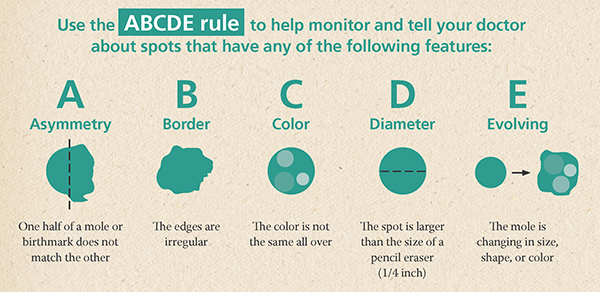Skin cancer is the most common form of cancer in the United States, and it is estimated
that one person dies from melanoma—the deadliest form of skin cancer—every
hour. Since May is
Skin Cancer Awareness Month, we want to provide you with some tips to help you be safe in the sun,
and also detect any early signs of skin cancer. Early detection of skin
cancer is essential, as most forms of skin cancer are curable if treated early.
Wear sunscreen. The general recommendation for sunscreen is to wear an SPF of at least
15 or greater, year-round. With so many brands to choose from, it can
be confusing when you are at the store. Consumer Reports has tested sunscreens
for effectiveness and quality, and have a
complete buying guide you can check out online. Sunscreen labels can also be confusing. For
example, do you want "sport" formulas, or ones specifically
for faces? For more information on how to read a sunscreen label,
check out this page that the Skin Cancer Foundation put together.
Wear sun protection. Clothing like long-sleeved shirts and/or hats can go a long way in skin
cancer prevention, and often you can find clothing that is breathable
and will protect you from the harmful UV rays from the sun.
See a Dermatologist annually. If you have never been to see a dermatologist, check out
this article by HealthCentral on what you can expect at your first visit.
Do monthly self-checks. While yearly visits with a dermatologist are important, you know your
skin best. Remember: Skin cancers found and removed early are almost always
curable. Be sure to check out the Skin Cancer Foundation's
Step by Step Skin Cancer Self-Examination.
Another thing to consider when examining your skin is to inspect any moles
you may have. Lots of people have moles on their body, and while most
are harmless you should still watch for any changes as this could be a
sign of melanoma skin cancer developing. Luckily, The American Cancer
Society provides a handy little guide to help you look for
signs of melanoma.
You can use the ABCDE rule to help monitor and tell your doctor about spots
that have any of the following features:
-
A - Asymmetry: One half of a mole or birthmark does not match the other.
-
B - Border: The edges are irregular, ragged, notched, or blurred.
-
C - Color: The color is not the same all over and may include shades of brown or
black, or sometimes with patches of pink, red, white, or blue.
-
D - Diameter: The spot is larger than 6 millimeters across (about ¼ inch –
the size of a pencil eraser), although melanomas can sometimes be smaller
than this.
-
E - Evolving: The mole is changing in size, shape, or color.
If you see something suspicious, make sure you follow up with your doctor.

Before you head outside this summer take an extra minute to practice the
tips above. You'll be doing yourself and your skin a huge favor.
The
Heptner Cancer Center provides comprehensive cancer care for most types of cancer, including
skin cancer. Radiation Oncologist
John Stamato, MD, FACRO, treats skin cancer using radiation therapy. Learn more at
www.cchwyo.org/cancercare or by calling 307.688.1950.
Have Questions?
Campbell County Health's
Wellness Services works to reduce health risks and promote overall wellness among employee
groups and individuals across the northeastern Wyoming region. To learn
more about Wellness, please visit
www.cchwyo.org/Wellness or call 307.688.8051.
This blog was written by Rachel Wilde CPT, MA, CCH Wellness Services Technician
and Phlebotomist